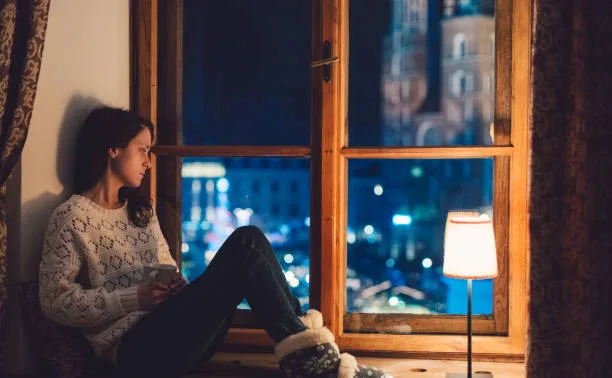Table of Contents
Introduction
The Winter months can be difficult for many people. Shorter days, cold weather, and less time spent outdoors can lead to the “Winter blues.” Seasonal affective disorder (SAD) impacts up to 10% of the population, causing symptoms of depression during the Winter. If you feel like the Winter months bring you down, you’re not alone.
Beating The Winter Blues
Here are 5 of the most effective ways to beat the Winter blues this season:
Light Therapy

Light therapy involves sitting in front of a light therapy box that emits bright light, mimicking natural outdoor light. Daily light therapy for 30 minutes or more can be extremely effective at reducing symptoms of Winter blues. Light therapy boxes filter out harmful UV rays and require just a simple brief daily commitment. Studies show that light therapy boosts mood, energy, focus, and sleep quality in people prone to Winter blues. Consider making light therapy part of your morning routine and you may see a dramatic difference in your Winter mindset.
Vitamin D

Vitamin D is produced in the skin from sunlight exposure, so less sun in the Winter means lower vitamin D levels for many people. Low vitamin D is linked to seasonal affective disorder, Winter blues, and depression. Taking a vitamin D supplement is an easy way to increase your levels, especially when sunshine is scarce. Aim for around 2000-4000 IU of vitamin D per day during the Winter months. Going for a short walk outdoors can also boost vitamin D levels a bit even on cloudy days. Keeping your vitamin D levels optimised is key to avoiding the Winter blues.
Exercise

Physical activity is nature’s antidepressant. Even a 30-minute walk can boost your mood powerfully. Exercise releases endorphins, reduces inflammation, relieves stress, and helps balance neurotransmitters in the brain for an overall sense of well-being. Getting fresh air and sunshine during Winter workouts provides extra benefits. Create an exercise routine you enjoy and stick with it consistently. Exercising 3-5 times per week will help significantly reduce Winter blues. Going to the gym or group fitness classes can also provide social interaction to further boost your mood.
Social Connection

Humans are social creatures by nature. Social isolation and loneliness make the Winter blues much worse for many people. Staying connected with friends and family makes a big difference. Schedule video chat dates, meet up safely in person when possible, join a book club or fun social group, volunteer in your community, or reach out to neighbours. Building social connections creates a sense of meaning and purpose during the Winter months. Quality social interaction is a key part of staying happy when the days are short and cold.
Self-Care Routines

Nurturing yourself is crucial during tough times. Self-care helps replenish mental and physical energy to take on each day. Dedicate time for restful sleep, soothing hot showers, cosy blankets, soothing music, good books, online yoga classes, journaling, and your favourite comforting foods. Create an atmosphere of hygge – a Danish concept of cosiness and contentment – in your living space. Light candles, drink herbal tea and create other comforting rituals. Taking good care of your mind and body prevents Winter blues from spiralling out of control into deeper depression. Make self-care a priority.
Conclusion

Implementing small daily habits with light therapy, vitamin D, exercise, socialising, and self-care makes a big difference in lifting Winter blues. Shift your mindset to embrace the season by getting outdoors frequently, trying new Winter activities, and focusing on the positive. With the right strategies, you can thrive all Winter long and enjoy the snowy season.
Don’t let the Winter blues keep you down – take active steps to boost your mood, energy and mental health. The right combination of light, healthy lifestyle habits, social connection, and self-care will have you feeling cheerful and bright even on the darkest Winter day.

FAQs
What is seasonal affective disorder (SAD) and what causes it?
Seasonal affective disorder (SAD) is a type of depression that occurs during the Winter months when there is less natural sunlight. It’s thought to be caused by disruptions in circadian rhythms and an imbalance in brain chemicals like serotonin due to the lack of sunlight exposure in Winter.
How can light therapy help with winter blues?
Light therapy involves sitting in front of a specialised light box that emits bright light and mimics natural outdoor light. The light enters through the eyes and signals the brain to reduce melatonin production and lift mood. Just 30 minutes per day can help reset circadian rhythms and boost mood, energy, and focus.
What are some ways to stay socially connected during the Winter?
Social isolation makes winter blues worse for many people. Stay connected by scheduling video chat dates with friends, joining an online book club or social group, volunteering in your community, reaching out to neighbours, or planning socially distant in-person meetups when possible.
Why is vitamin D important for beating the Winter blues?
Our bodies produce less vitamin D from sunlight in the Winter. Low vitamin D is linked to seasonal depression. Taking a supplement of 2000-4000 IU per day can optimise vitamin D levels when sunshine is scarce.
What are some self-care tips to lift your mood during Winter?
Self-care is key for managing Winter blues. Get adequate sleep, take hot showers, listen to music, practice yoga, journal, drink herbal tea, light candles, and create hygge in your home with cosy blankets and soothing rituals. Nurturing yourself prevents depression from worsening.



